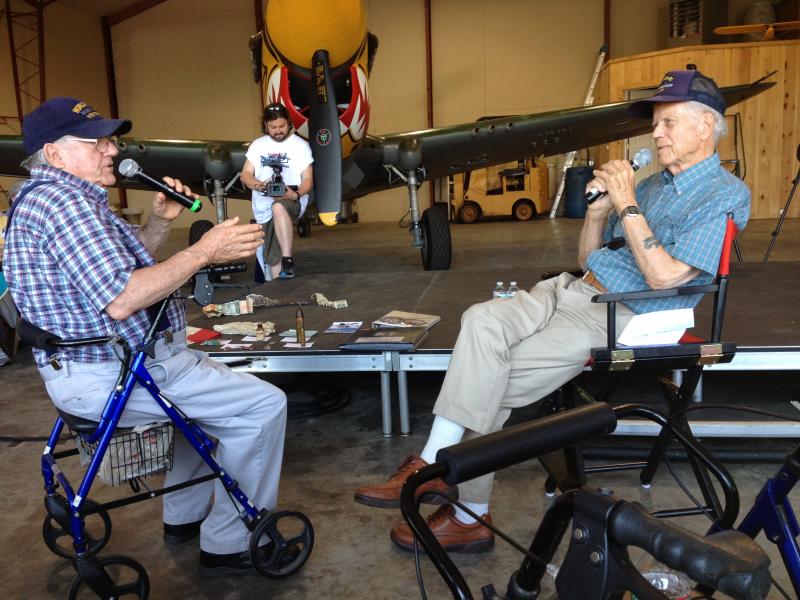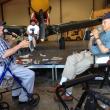Veterans' war stories steal the show
Under the snout of a snarling World War II fighter called the P-40 Warhawk, a group of veterans from the “Greatest Generaton” told a Wiscasset audience that their war ranged from terror to utter boredom.
Their war stories were a major highlight of the “Wings Over Wiscasset” air show and entertainment celebration held Tuesday, Aug. 6 at the town’s airport.
The vets’ audience included children, grandchildren and sometimes great-grandchildren, a host of flying enthusiasts and even total strangers.
And their tales kept the audience engaged.
Round Pond’s George Hanna, 88, was assigned to the USS Achenar, an attack cargo ship which participated in the Normandy landings in Europe, then was sent to the South Pacific to help out there.
On April 1, 1945, it was anchored near Okinawa as part of group of ships preparing for an invasion when it was attacked by a Japanese suicide pilot, a kamikaze.
Hanna said he heard the plane coming and turned around to watch it hit the side of his ship.
Ironically, Wiscasset’s Howard Cederlund, 88, watched Hanna’s ship as it was attacked.
He told the audience he was a sailor on a nearby ship when he saw the suicide pilot slam his plane into Hanna’s ship.
“It was terrible,” Hanna said. “They turned the mess deck into a hospital and laid bodies out on the tables.” The official record says they lost five sailors and had nearly 50 wounded.
Don McKibben, 92, of Topsham, was a fighter pilot who patrolled over the Normandy invasion looking for German aircraft that might attack the allied forces.
Enemy pilots stayed on the ground didn’t challenge the allied invasion so he flew back and forth for 13 hours and saw no opponents. It was boring, he said.
Former Master Sgt. James Sheppard, 88, South Portland grew up in New York City and was a trained and licensed aircraft mechanic. He joined the Army in hopes of being one of the first group of African American pilots, but was turned down.
“They said they needed mechanics more than they needed pilots,” he said.
He was part of the crew that kept the famed Tuskegee Airmen flying. That group provided air support for the American forces as they moved from North Africa up the Italian boot and kept the deadly German dive bombers called Stukas from attacking allied forces at the Anzio landing.
Ed Hendrickson, 92, Brewer, was a pilot of a carrier based dive bomber in the South Pacific.
While they dropped their bombs from 1,000 feet on the enemy, they had to fly 300 miles each way to reach their target and get back to home base.
The dive bombing missions “proved to be exciting at a time,” he said.
“You could see the enemy shells as then came towards the attacking planes. They looked like a grapefruit.”
“We were quite pleased when the (enemy) anti aircraft fire missed us,” he said.
George Jones, 89, Wiscasset was a radio operator on a B-25 medium bomber that was turned into a ground support aircraft.
He said some of his pilots flew so low that sometimes they came home with palm leaves stuck in their wings. “The B-25 was a happy plane but they were noisy,” he said.
Ed Dexter, 88, Waldoboro, was a navigator on a B-17 bomber that flew 32 missions over Europe.
“I didn’t want to be a bus driver,” he said referring to the pilots.
As the quartet of World War II fighters warmed up before they took off for a series of roaring passes over the crowd that including the moving “missing man” formation, Dexter, a retired engineer, said the loud sounds of the engines brought back memories.
“Just think what the sound of 100 planes with four engines sound like,” he said.
Event Date
Address
Wiscasset Airport
Wiscasset, ME
United States
























